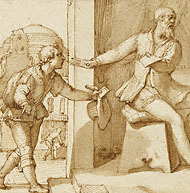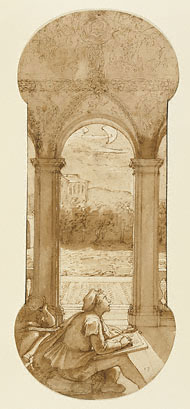|
Taddeo and Federico Zuccaro were two of the most creative draftsmen of the Renaissance. This exhibition examines their achievements and working relationship and explores the importance of drawing to an artist's education in Renaissance Rome. It also features a remarkable series of drawings by Federico that depicts Taddeo's rise from starving artist to acclaimed painter-star of late Renaissance Rome.
|
 |
|
Federico and Taddeo Zuccaro both left home at young ages to train as artists in Rome. Years later, Federico created an evocative and moving series of drawings depicting his beloved elder brother's struggle to find fame and fortune as an artist.
The series follows Taddeo as he moves from a provincial town to Rome at age 14, endures harsh treatment at the hands of employers, and diligently devotes himself to drawing. At last Taddeo triumphs, winning an important commission and eventually becoming the most important artist of his period in Rome.
In the fifth drawing in the series, shown at the top of this page, Taddeo turns away in tears as his painter-cousin rejects his plea for an apprenticeship. In the thirteenth drawing in the series, shown at left, the penniless Taddeo copies frescoes by Raphael by the light of a crescent moon. Powerful effects of light suggest Taddeo's almost religious fervor for drawing.
 See more of Taddeo's rags-to-riches tale. See more of Taddeo's rags-to-riches tale.
|
 |
|
Federico and Taddeo Zuccaro both became highly successful artists, receiving multiple commissions from the Pope and from great Roman families. Working together until Taddeo's death at age 37, the brothers painted frescoes (wall paintings on wet plaster) for palace interiors and house facades, chapels, and pleasure villas outside Rome. Taddeo and Federico had similar styles but distinctive approaches: Taddeo was a free-spirited and spontaneous draftsman, while Federico created clearer, more carefully considered compositions.
Soldiers carry a model of the vanquished city of Veio in the preparatory drawing by Taddeo shown above for the facade of the Palazzo Mattei in Rome. Such processions were popular subjects, well suited to the bands of space across facades. Taddeo's drawing is a finished model for the fresco, which has since been weathered away, with a concentration on contrasts of light and shade.
|
 |
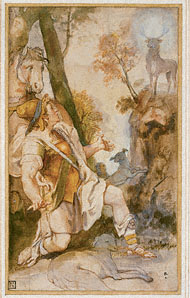
 |
 |
The Vision of Saint Eustace, Federico Zuccaro, 1542–1609
|
 |
 |
|
|
 |
Taddeo helped Federico win his first major commission, to paint a facade fresco in Piazza Sant'Eustachio in Rome. In this preparatory drawing, identical to the final fresco, Eustace comes across a white stag with a crucifix between its antlers, a vision that inspired his conversion to Christianity. Federico places Eustace in an angled pose through which he shares his vision with the viewer.
When Federico began to execute the fresco, Taddeo interfered by retouching it without permission. Federico exploded and destroyed Taddeo's work; they reconciled on the understanding that Taddeo could retouch Federico's drawings and cartoons, but never his works in fresco, oil, or any other medium.
|
 |
 |
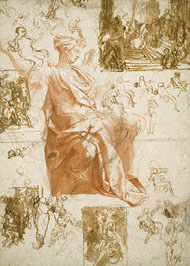
 |
 |
Studies for The Blinding of Elymas, Sacrifice at Lystra, and A Holy Family, Taddeo Zuccaro, 1558/59–1566
|
 |
 |
|
This sheet of studies for Taddeo's frescoes in the Frangipani Chapel is one of his most momentous surviving drawings.
A large figure study in red wash dominates the sheet, with several thumbnail sketches distributed around it.
Red wash was an unusual technique for the period, and Taddeo used it with great effectiveness.
|
 |
|
During the Renaissance, students flocked to Rome to improve their skill by sketching from ancient and contemporary masterpieces. Taddeo and Federico absorbed the art of the past by drawing the artistic wonders of Rome, from ancient statuary to the frescoes of Michelangelo, Raphael, and Polidoro da Caravaggio.
In this drawing, Federico depicted Saint Peter's Basilica as it appeared before the Baroque transformation of this area of Rome. Michelangelo had already begun the design of the mighty dome of the vast basilica, which was eventually completed after his death; the lantern at its top was finished in 1603.
|
 |
 |
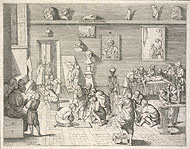
 |
 |
A Painters' Academy, Pietro Francesco Alberti, about 1625
|
 |
 |
|
 |
|
Artists' academies were founded all over Italy to supplement training that youngsters might receive from a master, if they were lucky enough to have one. This print shows all the activities associated with teaching in an academy: students make architectural drawings, study mathematics or perspective on the ground, fashion figures from clay, and make copies from a skeleton. In the background, a group undertakes the dissection of a corpse.
Federico Zuccaro was instrumental in the development of the Academy of Saint Luke in Rome, an artist's academy that still exists today. According to his will, Federico also intended his palace to house an artists' academy and a hostel for poor young artists who, like his adored elder brother, often came to Rome without a place to stay.
|
 |
